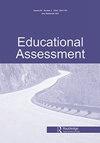新冠肺炎康复资源配置:三项学校需求指标的比较
IF 2.3
Q1 EDUCATION & EDUCATIONAL RESEARCH
引用次数: 2
摘要
摘要随着学生在2021-2022学年重返现场教学,当地教育机构(LEA)必须制定资源分配策略,以支持有需要的学校。联邦计划提供了资源来支持重启和恢复。然而,对于LEA如何将资源用于支持那些最需要的学校,几乎没有达成共识。本研究调查了三个学校需求指标(即新冠肺炎疫情前的学生表现和进步、学校和社区贫困以及疫情脆弱性)与整个疫情期间学生表现和进展指标之间的关系,以确定哪些指标支持有效的学校需求推断。我们发现,与新冠疫情前的学术指标相比,学校贫困对疫情期间的表现和进步的预测更为强烈。在小学,我们发现,即使以贫困和疫情前的成绩为条件,疫情的脆弱性也能独立预测成绩。在我们调查的贫困指标中,符合免费和降价午餐条件的学生的百分比是最有力的预测因素。本文章由计算机程序翻译,如有差异,请以英文原文为准。
Allocating Resources for COVID-19 Recovery: A Comparison of Three Indicators of School Need
ABSTRACT As students return to in-person instruction in the 2021–2022 school year, local education agencies (LEAs) must develop resource allocation strategies to support schools in need. Federal programs have provided resources to support restart and recovery. However, there is little consensus on how LEAs can target resources to support those schools most in need. This study investigates the relationship between three school need indicators (i.e., pre-COVID student performance and progress, school and community poverty, and pandemic vulnerability) and measures of student performance and progress throughout the pandemic to determine which indicators support valid school need inferences. We find that school poverty more strongly predicts performance and progress during the pandemic than pre-COVID academic measures. In elementary schools, we find that pandemic vulnerability independently predicts achievement even when conditioning on poverty and pre-pandemic achievement. Of the indicators of poverty we investigated, the percentage of free and reduced-price lunch-eligible students is the strongest predictor.
求助全文
通过发布文献求助,成功后即可免费获取论文全文。
去求助
来源期刊

Educational Assessment
EDUCATION & EDUCATIONAL RESEARCH-
CiteScore
3.20
自引率
6.70%
发文量
24
期刊介绍:
Educational Assessment publishes original research and scholarship on the assessment of individuals, groups, and programs in educational settings. It includes theory, methodological approaches and empirical research in the appraisal of the learning and achievement of students and teachers, young children and adults, and novices and experts. The journal reports on current large-scale testing practices, discusses alternative approaches, presents scholarship on classroom assessment practices and includes assessment topics debated at the national level. It welcomes both conceptual and empirical pieces and encourages articles that provide a strong bridge between theory and/or empirical research and the implications for educational policy and/or practice.
 求助内容:
求助内容: 应助结果提醒方式:
应助结果提醒方式:


